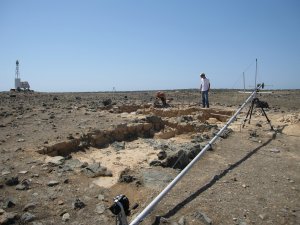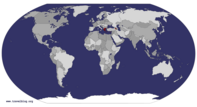Advertisement
Published: June 15th 2009

 Krisi
Krisi
Kroni (right), who is the Center's photographer, prepares one of the trenches on Krisi to photograph. The camera works on the boom (far right) and can take birds-eye views of the trenches from 20 or so feet up.This week started off rather slowly. Monday and Tuesday featured me sitting at the center checking my email 4,000 times, reading up on the world news, and doing some research in the library here at INSTAP. I shouldn't complain really, since I've had time to catch up on some work. Then, I spent my evenings making friends with a local taverna owner named Manoles and by default practicing my Greek. My reliable dinner companions were a beer, a book, and the sun setting over the western part of the Pacheia Amos bay-- not terribly exciting, but serene and relaxing. Wednesday morning brought a welcomed end to my lazy and rather boring days-- that's when Tom Brogan, the director here at INSTAP realized that I actually could be put to work, and he wasted little time doing so. Tom was just finishing up a month-long excavation at a site on the island of Krisi. Pronounced Kree-see, and meaning "gold" or "golden" in Greek, the island boasts one of the most beautiful gold sand beaches in Crete...unfortunately my only exposure to it was as we passed it on the boat to and from the island each day. The island is located about ten

 No Fantail Guppies here...
No Fantail Guppies here...
These stone "fish tanks" were probably built by the Minoans in order to attract or keep murex. miles off the coast of southern Crete and the site itself has evidence for human occupations in the Neolithic through Roman periods, with the major occupations occurring during the Bronze Age (what Tom and his team were interested in) and the Roman period (a number of Roman tombs, plus a small Roman site serve as proof). This is the third season of excavation at Krisi, and Tom hopes to be able to do some more work in September. The results have been fantastic, with the excavations uncovering Minoan houses, tremendous amounts of drinking cups and fine-serving vessels (something like the ancient equivalent of crystal stem-ware and Mom's good China). But, perhaps the most exciting aspect of the excavation comes from the presence of thousands, perhaps hundreds of thousands, of murex shells (murex are a species of carnivorous sea snail), and two man-made, stone "fish-tanks" off the northern coast of the island. Together with some stone-lined processing vats in the houses, these seem to indicate purple dye production. These murex shells would have been crushed and processed in order to produce a purple dye (the same purple dye that for thousands of years was considered the "Royal color," and used to

 The "Poseidon"
The "Poseidon"
After dropping a load of passengers off, our chartered fishing boat heads back to Krisi to pick up the rest.dye the robes worn by elites such as Roman senators and emperors or Medieval royalty). The fish tanks themselves may have actually been traps of a sort, where Minoan murex harvesters would have attempted to create an artificial colony of murex by baiting the enclosures in order to attract the shell-fish . An intriguing hypothesis, but one which still lacks any real hard evidence.
Anyway, I was there helping clean the excavation trenches and take photos of them before they were filled in (so that no person or animal could fall into them and get hurt). So Wednesday and Friday saw me up at the crack of dawn, to catch a ride to the port of Ierapetra (pronounced He-rah-petra) on the south coast, to board the "Poseidon" a chartered fishing-boat and enjoy a half-an-hour commute to the island. The waves were a bit rough on Friday, and I got completely drenched on the way back from the island, but spending time at Krisi and seeing the archaeological site was well worth it.
I spent Thursday hard at work cleaning patches of land at another Minoan archaeological site called Papadiokambos (pronounced Papa-thee-o-ka-bose). It was a strenuous day of work, but

 Knossos...and Me
Knossos...and Me
The reconstruction in the background is totally artificial and really not well attested to from the archaeological evidence. But it allows visitors to get a feel for the type of architecture that might have been at Knossos. Only one problem: did they have to build it right on top of the actual archaeology?!again well worth it. Another site that Tom has been working on, "PapaD" as its known to the archaeologists at the center, is a Minoan port town on the north coast of the island, about an hours' drive east of Pacheia Amos. The excavations there are in their infancy-- I think only one season so far, with the aim to do more work there in August-- but already they have uncovered a full Minoan house. The site is located on 20-30 foot limestone cliffs, with a stone beach below, and probably served as an imported coastal entrepot in the Bronze Age. Tom hopes to find what he's been calling the "Manor House" or "villa" this summer-- the home of the head family of the town-- and so he has enlisted Antonia (with me to help) to do some Ground Penetrating Radar work there. The hope is that the GPR will pick up evidence for monumental, large-scale architecture and allow Tom to pinpoint his excavations. But, since the GPR needs to pass flush against the ground, survey areas need to be cleared of rocks and brush before bringing the GPR out. We cleared the areas on Thursday-- and will go back

 Would the real Knossos please stand up?
Would the real Knossos please stand up?
This picture gives a good idea of what Knossos has to offer. In the foreground the actual archaeological remains...in the background Evans' reconstructions- perhaps more pleasing to the eye, but also potentially wrong.on Tuesday and Wednesday of this week to do the actual GPR survey.
After a few days of serious labor (I have the callouses to prove it), Friday night there was a talk at the Kentro by a world-renowned archaeologist named Todd Whitelaw, regarding the use of archaeological surface survey to map out the extent of the most important Bronze Age site on Crete, the city of Knossos. Pronounced like it's spelled, K-no-sos, the excavated portion represents the major administrative at the center of the city, also known as the "palace." Knossos has been (playfully) interpreted as the seat of King Minos (the father of the mythological Minotaur) and some believe that the labyrthine ground plan of the palace, along with a strange bull-leaping or bull-fighting ritual depicted in some frescos at the site, inspired the tale of the Minotaur and the Labyrinth found in later Greek myth. It was excavated in the early 20th century by an eccentric Brit named Sir Arthur Evans-- who used methods of excavation and reconstruction that are more akin to looting and amusement park building than modern archaeology. Whitelaw is hoping to learn more about the city that surrounded the palatial center. It

 Sweep the Leg!
Sweep the Leg!
As the sun set, I was channeling Mr. Miyagiwas a great talk, and better yet, archaeologists from all over the island descended on the center to hear Todd's take on things and to enjoy the free dinner and beverages supplied by INSTAP. It was a really nice night, and I was able to meet some more interesting and influential archaeologists.
With Saturday and Sunday as days off, the Mochlos crowd (the students from UNC-Greensboro working at the archaeological site of Mochlos who I will be joining in about a week) and I traipsed off to Heraklion, the capital of Crete, the largest city on the island, and the location of Knossos. We started by seeing the archaeological site, which was enhanced and rebuilt in concrete in places by Evans (according to his own imagination, with little real evidence to back up his reconstructions). It is a Mecca for archaeologists, especially those studying Aegean Prehistory like me, but I found myself disappointed and saddened by the massive (and we now know, somewhat wrong) concrete embellishments that Evans undertook during his work there. On the one hand, Evans' reconstructions allow visitors to get a very rough idea of the Minoan palace might have looked like, but on the other,

 Daniel-sahn
Daniel-sahn
Out on the sea-wall, with the sun setting, I was struck with a moment of sheer photographic genius... and no, there was no Raki involved at this point of the evening.his concrete buildings suggest a Knossos that may never have existed except in his mind. We simply don't have enough evidence (partially due to Evans' dubious methods) to know what the upper floors of the palace looked like, or what the purpose of any number of the rooms was. It is upsetting that his wrong interpretations are now "set in stone," and because of this, unknowing visitors get a wrong, or at least unsubstantiated, impression of the site. It is a very complicated and difficult issue to grapple with-- If only Evans, in the 1920s, had had the ability to display his interpretations through a changeable medium like holograms or virtual reality, instead of permanent stone and concrete. Nevertheless, walking through the Palace of Knossos, a place I had read about hundreds of times, was utterly amazing.
We spent the afternoon at the Archaeological Museum looking at all the artifacts from Knossos, including tons of beautiful pottery, gold jewelry, bronze and silver swords, and stone vases. We then walked out along the long (maybe about a mile) sea-wall that protects Heraklion's port from the open-sea and watched the sunset there. Here was a photo-op that I just couldn't pass

 The Crew
The Crew
The Mochlos gang and me.up, so in the fading twilight on the top of the sea-wall, a few of my friends and I feigned Karate Kid moves to capture some really fantastic (and admittedly silly) pictures. Dinner in the town square, chased with complimentary raki (rah-kee is the Cretan version of Grappa, and the local's liquor of choice. It is common for larger dinner groups to recieve complimentary home-made raki and fresh fruit after the meal) and watermelon and some dancing at a local bar, rounded out a great weekend.
Today marks my third Sunday in Crete, and Pacheia Amos, the INSTAP Center, and simply the entire experience is starting to feel rather routine and comfortable. This, of course, means its time to mix things up a bit. On Wednesday I will be leaving Pacheia Amos, and my "home base" at the Golden Beach Hotel for good. I will spend 4 days working with a team who is mapping a Neolithic cave in central Crete using a very exciting piece of laser equipment nicknamed the "Cloud-Scanner." This $100,000 machine uses lasers to map, in 3D, spaces of up to hundreds of square meters. Should be exciting. On Sunday or Monday I will be descending on Mochlos and will begin my three week stay there with my friends at the Mochlos team. I'll be working as a trench supervisor for the excavation on the island.
I hope this post finds you all well and that you're all enjoying the blog. I have to say, I look forward to sharing my adventures every week-- and the process of writing down my thoughts and filtering my experiences has been both fulfilling and tons of fun, and has really allowed me to internalize these experiences. So, thanks for being a part of this.
Best wishes and be well,
Jeff
Advertisement
Tot: 0.094s; Tpl: 0.012s; cc: 7; qc: 45; dbt: 0.0691s; 1; m:domysql w:travelblog (10.17.0.13); sld: 1;
; mem: 1.2mb









Jud
non-member comment
-
Jeff, Another great posting, keep 'em coming. -Jud